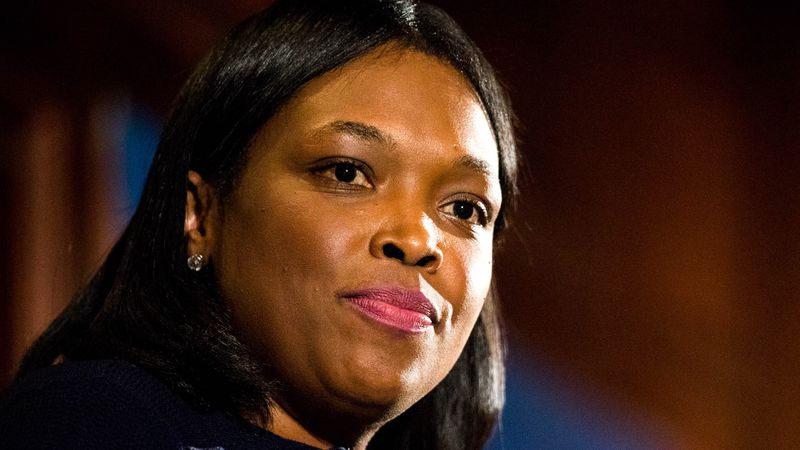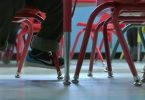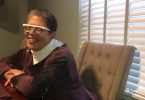
Chicago Public Schools CEO Janice Jackson speaks about schools during a City Club of Chicago luncheon on July 16, 2018. (Courtney Pedroza/Chicago Tribune)
Chicago’s South and West sides have lower concentrations of highest-rated schools than other areas, and black and Latino students attend top schools at far lower rates than their white counterparts, according to a new Chicago Public Schools report on enrollment and academic data.
The report also makes clear the district, which has seen enrollment dwindling for years, is operating vastly under capacity. There is space for about 150,000 more students in a district that last year had enrollment of about 371,000 in 650 schools, the report said. And enrollment is expected to decline by another 5 percent over the next three years.
Students have also left their neighborhoods to attend school in other parts of the city at higher rates during the last four years, according to the district-sponsored analysis, which underscores ongoing community worries about equity and the consequences of school choice in the massive urban system.
But city officials hope to use their latest collection of charts and maps to carry out discussions about the future of CPS, and potential decisions to close more schools.
“There’ll be choices that we have to make now that parents have made their choice, that’s true,” Mayor Rahm Emanuel told the Tribune on Friday. “But we’re involving residents and, most importantly, parents in that process, which it wasn’t before.”
CPS CEO Janice Jackson said the data would offer residents “a comprehensive picture of the educational landscape in their community.”
“I believe that it’s our job as a district to connect the dots and make sure that parents and community members — as well as educators, who are the best people suited to make decisions about what should happen in their schools and community — have all of that information in one spot so that they can make decisions with the district, and not have the district make decisions for them.”
The CPS analysis released Friday breaks down 16 regions of the city, and shows South Side and West Side neighborhoods have the lowest concentrations of highly rated elementary and high school programs. All of the schools in a large North Side region defined by CPS as Greater Lincoln Park have the district’s highest performance ratings. In one West Side region, however, only 35 percent of the schools achieve those high ratings.
Citywide, 45 percent of black students attend Level 1 or 1-plus schools, while 91 percent of white students attend the top rated schools.
CPS developed its analysis with the Kids First Chicago organization. That’s the latest name for an education reform group founded by the Commercial Club of Chicago to work as a key fundraiser for former Mayor Richard M. Daley’s Renaissance 2010 initiative, which aimed to shut down underperforming schools and largely replace them with dozens of independently operated charter schools.
This time, the mayor and CPS launched a new process that will have existing schools apply to add programs such as International Baccalaureate or fine arts to their curriculum. Buildings awarded with the new programs will be announced next spring, the district said.
That strategy is consistent with the city’s past practice of expanding the number of school options families can choose from amid declining overall enrollment.
One consequence, though, can be found at a host of under-enrolled schools that have struggled to retain students, resources and quality education programs.
Today, according to the CPS analysis, slightly less than 60 percent of elementary students and less than a quarter of high school students attend the school that’s automatically assigned to them based on where they live.
“My approach is to start with the investment, to make people excited about the schools in their community in hopes of bringing people back to those communities. That’s the first step,” Jackson told reporters during a visit to Fiske Elementary in the West Woodlawn neighborhood.
“But we’ve also had conversations where community members themselves have seen some of these issues, and they want an opportunity to sit at the table and address it,” Jackson said. “It’s not an issue around closing or not closing that bothers community members, as much as it is involvement in the process.”
Still, Emanuel defended the strategy to expand the amount of school options available to families amid declining overall enrollment.
“I’ve made quality my priority,” Emanuel said. “The debate is not about choice, the debate is about quality versus mediocrity.”
“Once you give parents information, they have a choice to make. The choice is between quality,” he said, pointing to data from the GoCPS high school application process that showed arts programs, career and technical education programs, and schools with high district performance ratings tended to have higher demand from families.
When asked what the city must do about schools that are left behind by those choices, Emanuel said that was part of “an ongoing discussion.”
“And I think that is a fair discussion, but it’s not the only discussion. My first commitment, and I agree with Janice, is about making sure that you’re making these investments in our neighborhood schools,” Emanuel said.
Twitter @PerezJr






